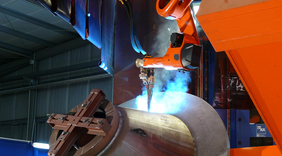
1. Introduction:
For a foreign trade-focused country such as Germany, a powerful, internationally competitive, metal machining industry is of immense significance to the overall economy. The term "Made in Germany" is still today a quality brand for goods produced in Germany and puts the producing industry on an internationally well accepted pedestal. It is therefore necessary to maintain and to increase the sector's efficiency and productivity at a high level over the long term, in order to keep pace, in particular with global competitors. At the same time, the efficiency in production must not suffer from the enormous pressure so that in future goods with the "Made in Germany" brand can still reach the world markets.
As welding technology plays a decisive roll for these companies, the entrepreneurs have to follow up the developments and innovations of the technologies which are useful for them. On one hand, the manufacturers for welding technologies continuously develop innovations thus providing opportunities to optimise the own production. But it is not always easy to choose the right solution for the own requirement from the multitude of offers. On the other hand, companies always demand new solutions because their requirements cannot be realised with the current technology.
Thus, for example, high tensile fine grain construction steels (S690 and higher) and stainless nickel-chrome steels are used more and more as well as normal construction steel (S235 or S355). Where lightweight design plays a significant role, aluminium materials and lightweight constructions become more and more interesting.
The metal machining industry also experiences immense versatility in terms of material thicknesses. While in some industries a 2 mm thick sheet is classified as thick sheet, other industries use 10 mm only for the type plates.
Thus, the metal machining industry offers numerous application possibilities and a major development potential for production engineering developments in general and in joining technology in particular.
Firstly, let's take a look at the mainly used welding processes. Secondly we look at the welding processes which, due to their technological advantages, are enjoying increasing popularity but are not yet so widely distributed. Individual examples of the automated use of robots with sensor application will also be presented.
2. Gas shielded metal arc welding (MIG/MAG)
The most widespread welding processes in the metal machining industries are the gas shielded metal arc (MIG/MAG) welding processes. Here we mainly differ between the classic arc types "short arc", "transitional arc" or "spray arc" and various "pulsed arcs". The classic arc types can be generated with simple step-switch machines whereas modern arcs mostly require digital controlled power sources. The advantages of these arcs include improved heat control and a safe and controlled drop separation at the end of the welding current pulse phase. This ensures that the drop is separated before the wire end can dip into the liquid melt. This would lead to short-circuits and therefore to serious spatter formation. The pulsed arc is well suited to a wide variety of welding tasks because it runs in a very stable manner and guarantees deep, safe penetration. It is used both manually and automated. With regard to the pulse control, most power source manufacturers incor-porate an I/I control, in which both the pulse phase and the base current phase are current-controlled. Some manufacturers also offer a V/I control for pulsed arcs, in which the pulse phase is voltage-controlled and the base voltage phase is current-controlled. The picture shows the stylised form of a pulse process with the appropriate photos of a high-speed camera. The magnetic forces generated by the current separate the drop at the peak of the pulse phase before the wire end can dip into the liquid melt. Thus, there is no short circuit.
Carl Cloos Schweisstechnik GmbH
Carl-Cloos-Strasse 1, 35708 Haiger
Stefanie Nüchtern-Baumhoff
Tel. +49 (0)2773 85-478
E-Mail: stefanie.nuechtern@cloos.de